Instructions on how to properly salt cabbage for the winter in a saucepan with the addition of various ingredients
Juicy and crispy salted cabbage – an invariable component of the autumn-winter diet. According to the traditional recipe, it is salted with carrots and salt without additional ingredients. For better taste and piquancy, add sour berries, apples, horseradish, pepper, bay leaf, and caraway seeds. In recipes for quick pickling with hot marinade, honey is used instead of sugar.
How to properly salt cabbage for the winter in a saucepan and which one exactly dishes it is suitable for this, we will tell you in our article.
Features of salting cabbage in a pan
Before describing the advantages and disadvantages of pickling cabbage, let us recall that there is a fundamental difference between traditional pickled and salted products.
Previously, salt was worth its weight in gold, and people did not use it in such quantities as they do now. A different method was used to preserve vegetables – fermentation. The traditional recipe excluded use of salt. Shredded cabbage was mixed with carrots and apples, filled with water and placed under pressure.
Reference. Lactic acid bacteria promote the release of lactic acid. It inhibits the development of mold fungi and enriches the taste of vegetables.
The dry salting method replaced fermentation. It is fast and simple. Table salt acts as a preservative. To improve the taste, carrots, sweet and hot peppers, cumin, dill, lingonberries, cranberries, sour and sweet and sour apples are added to cabbage.
The main advantage of pickling cabbage is its high level of preservation at a temperature not exceeding +18°C. Disadvantage – less benefit to the body compared to fermented cabbage.
Which pan to choose
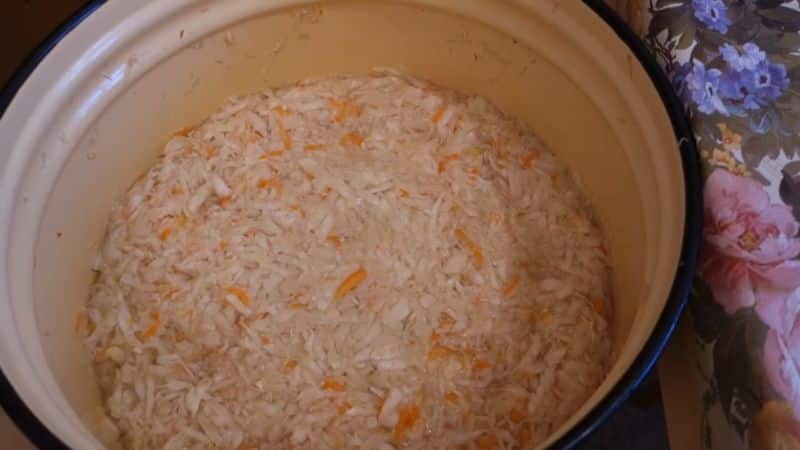
Previously, cabbage was fermented in wooden barrels; now housewives use pots, buckets, and jars for this purpose. Many households have utensils made of aluminum, steel or cast iron.
When choosing a container for pickling cabbage, take into account the following nuances:
- when in contact with metal, vegetables darken;
- the alkali and acid from the brine enter into a chemical reaction with aluminum, which causes the taste of the finished product to deteriorate - a metallic taste is felt.
Is it possible to ferment in an enamel pan? Many people have been using it for several years. The coating of the container must be smooth, without chips or cracks, so that the released acid does not come into contact with the metal. To make aluminum cookware, they often use not a pure alloy, but a mixture with zinc or beryllium. In this case, during the chemical reaction, compounds hazardous to human health are released. The result is poisoning and digestive disorders.
Selection and preparation of the main ingredient
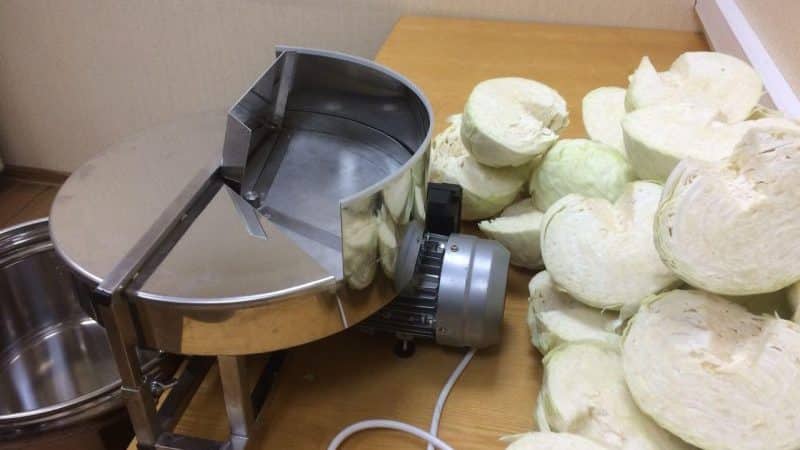
Winter varieties with a dense leaf structure are suitable for pickling. Such vegetables are stored longer and do not soften during fermentation.
The leaves should be juicy, white, without dark spots, cracks or signs of rot.
The larger the head, the better and tastier the salted cabbage. It is better to shred ½ or ¼ of a large fork than 2 small ones.
Before use, wash the product and remove the top leaves. Start cutting. A special shredder with one, or even better, two sharp blades is ideal for this purpose. If you don’t have such a kitchen appliance, use a vegetable peeler or large grater.Manual or electric shredders greatly facilitate the slicing process.
The photo shows options for chopping vegetables.
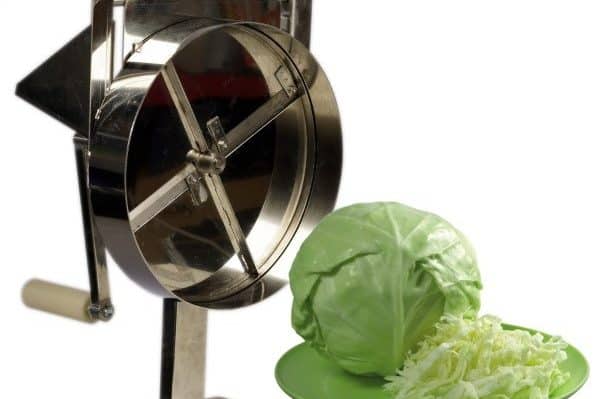
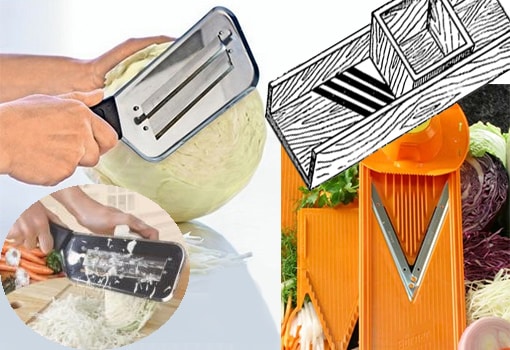
Classic salting method
The traditional recipe requires the use of three ingredients:
- white cabbage – 1 kg;
- large carrots – 1 pc.;
- salt – 25 g.
Preparation:
- Shredded cabbage is combined with grated carrots and salt. It is convenient to do this in a deep plastic or enamel bowl. Vegetables are crushed and rubbed by hand.
- The resulting slice is placed in a clean container, pressed down with a wooden board or a wide flat plate suitable in diameter. A three-liter jar or stone is placed on top.
- The pan is left for 4-6 days at room temperature. Sauerkraut is transferred to glass jars.
Recipe options
The traditional recipe has many variations. Vegetables are mixed with cranberries, apples, caraway seeds, beets, bay leaves, horseradish, sugar, and honey.
Pickling young cabbage
Young cabbage is often used to prepare summer salads due to the delicate structure of the leaves. Young heads of cabbage are suitable for an express snack option. We suggest you try it recipe quick salting of cabbage in large pieces.
Ingredients:
- young cabbage – 2 kg;
- carrots – 2 pcs.;
- salt – 50 g;
- sugar – 25 g.
Preparation:
- The carrots are grated, the cabbage is cut into large layers.
- Vegetables are placed in a deep container, sugar and salt are added. They knead with their hands.
- The vegetable mixture is transferred to a saucepan and placed under pressure for 1-2 days.
With carrots and sugar
Sugar in this recipe is added to speed up the fermentation process. The salting process takes no more than 2 days.
Ingredients:
- white cabbage – 2.5 kg;
- carrots – 3 pcs.;
- salt – 60 g;
- sugar – 40 g;
- water – 3 l.
Preparation:
- Shredded cabbage and grated carrots are crushed with your hands until the juice appears and transferred to a saucepan.
- Water is boiled with salt and sugar until the crystals dissolve.
- The vegetables are poured with brine, cooled to room temperature, cabbage leaves are placed on top and pressure is applied.
With apples
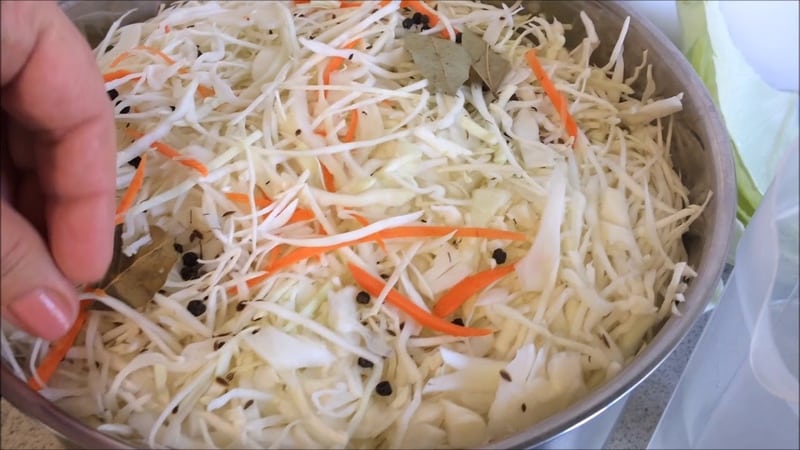
The apples are not at all unnecessary in this recipe - they add sweetness.
Ingredients:
- white cabbage – 2 kg;
- apples – 6 pcs.;
- salt – 50 g;
- sugar – 30 g;
- bay leaf – 3 pcs.;
- black and allspice peas - to taste;
- carrots – 2 pcs.
Preparation:
- The apples are washed, the seed capsule is removed and cut into small pieces.
- The cabbage is chopped, the carrots are grated, sugar and salt are added and kneaded with hands.
- Place apples and vegetables in a pan, alternating layers and sprinkling with spices. They put pressure on top and put it in a warm place for a week.
With cranberries
The sour berry adds a piquant flavor to the appetizer. Cranberries can be replaced with lingonberries, rowan berries, viburnum, or used all at once.
Ingredients:
- cabbage – 3 kg;
- carrots – 2 pcs.;
- salt – 60 g;
- cranberries – 150 g.
Preparation:
- Shredded vegetables are mixed with salt and kneaded with hands until juice appears.
- Add cranberries to the vegetables, mix and transfer to a saucepan.
- Place a flat plate on top and place a jar of water.
With cumin
A spice with a spicy and piquant aroma, tart and bitter taste will enrich the dish.
Ingredients:
- white cabbage – 2 kg;
- carrots – 1 pc.;
- salt – 50 g;
- cumin – 50 g.
Preparation:
- Shredded cabbage is mixed with grated carrots and salt and kneaded with hands until juice appears.
- Mix vegetables with cumin and transfer to a saucepan.
- Place a flat plate on top and put pressure on it.
With beets
Beets give cabbage a nice pinkish color.This appetizer looks elegant on the table.
Ingredients:
- cabbage – 3 kg;
- beets – 2 pcs.;
- carrots – 2 pcs.;
- water – 3 l;
- salt – 80 g;
- garlic – 2 cloves;
- sugar – 40 g;
- dill branches - to taste.
Preparation:
- The prepared main product is mixed with chopped beets and carrots and kneaded with hands until the juice is released.
- Garlic is passed through a press and added to vegetables.
- Place sprigs of dill on the bottom of the pan, then the vegetable mixture. Pack tightly.
- Prepare a hot brine with salt and sugar and pour in the vegetable mixture. They put pressure on top and put it in a warm place for 12 hours. Every day the oppression is removed and pierce Use a long wooden spatula or stick to bleed the vegetable mixture to release the carbon dioxide.
With horseradish
This recipe will appeal to connoisseurs of savory snacks. Preparation with horseradish root is obtained crispy and fragrant.
Ingredients:
- cabbage – 2.5 kg;
- carrots – 2 pcs.;
- horseradish root – 1 pc.;
- garlic – 1 head;
- water – 3.5 l;
- salt – 60 g;
- sugar – 100 g;
- black peppercorns - to taste.
Preparation:
- Mix chopped vegetables in a deep bowl.
- Horseradish root is grated and added to vegetables. The mixture is kneaded until the juice appears.
- A brine is made from water, salt, sugar, and pepper and poured over the vegetable mixture.
- They put oppression on top. In 10-12 hours the cabbage will be ready.
With garlic
This appetizer has a light garlic aroma and a spicy taste.
Reference. Iodized salt is not used - it softens the structure of vegetables, making them slippery and unsuitable for consumption.
Ingredients:
- cabbage – 1 kg;
- carrots – 1 pc.;
- sunflower oil – 100 ml;
- sugar – 15 g;
- salt – 25 g;
- apple cider vinegar – 50 ml;
- water – 0.5 l;
- garlic – 2 cloves.
Preparation:
- Chopped vegetables are mixed with garlic passed through a press.
- Brine is made from water, sugar, salt and oil, and vinegar is added.
- Vegetables are poured with boiling liquid and placed under pressure. The appetizer will be ready in 5-6 hours.
With honey
Our great-grandmothers used this recipe. Instead of sugar, honey was added to the brine.
Ingredients:
- white cabbage – 3 kg;
- carrots – 3 pcs.;
- water – 1 l;
- salt – 60 g;
- honey - 2 tbsp. l.
Preparation:
- Cabbage and carrots are chopped and crushed by hand. The mixture is transferred into a saucepan.
- Add salt to boiling water and stir until completely dissolved. Cool to a temperature of +40°C and dissolve honey in brine.
- The prepared brine is poured over the vegetables and placed under pressure for 5-6 days.
Features of storing salted cabbage
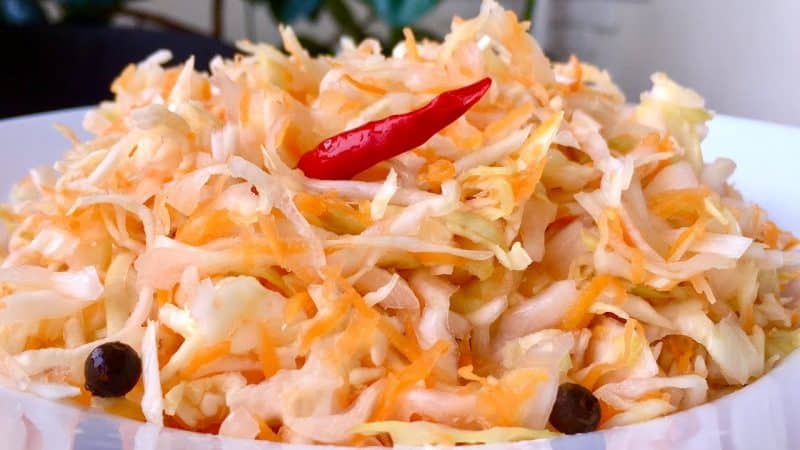
Salted cabbage retains its crunchiness and does not become moldy, but brine does not become cloudy at a temperature of +1...+5°C and air humidity of 80-90%. In such conditions, the product is stored for 6-8 months.
At temperatures above +5°C, fermentation continues and the taste of the product deteriorates.
The salted cabbage is transferred to clean glass jars and placed in the refrigerator (if space allows), on a glazed balcony or in the cellar. The workpiece is also packaged in portions in plastic bags and placed in the freezer. The structure and taste of cabbage do not change when frozen.
Advice from experienced housewives
To keep salted cabbage longer and not change color, structure and taste, take note of the recommendations of housewives:
- For pickling, take dense, round heads of cabbage - they are much juicier than flattened ones.
- Heads of cabbage lightly beaten by frost are suitable for pickling and pickling. They contain the maximum amount of sugar, and the taste of the snack is excellent.
- For quick pickling, vegetables are poured with hot brine.
- Sugar slightly softens the structure of the leaves, so it is important not to overexpose the products in a warm place.
- Cabbage for pickling is cut in different ways: into pieces, thick or thin strips. However, when dry salting, large pieces take longer to ferment; it is advisable to fill them with hot brine.
- The surface of the workpiece must be covered with brine, otherwise the cabbage will darken.
- The darkened top layer is removed and the vegetables are mixed using movements from bottom to top.
- The finished product is placed in glass jars and refrigerated.
- Instead of an enameled one, use a clay or glass container.
- Bay leaves and sprigs of herbs are placed at the bottom of the container.
Conclusion
Dry salted cabbage using salt is a classic recipe in our country. However, previously they did not put salt in cabbage, but prepared a pickled fermented product with the addition of berries and water.
Over time, the recipes have improved. Nowadays, salted cabbage is prepared with the addition of sugar, table or apple cider vinegar, bay leaf and spices. Instead of wooden barrels, enamel, glass or clay pans are used.